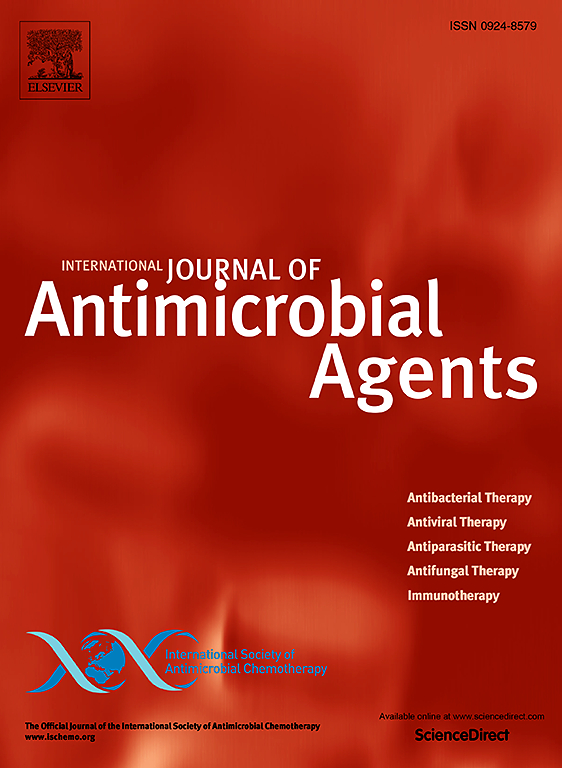Long-distance transmission of tmexCD1-toprJ1 positive Klebsiella pneumoniae between humans and food animals
IF 4.6
2区 医学
Q1 INFECTIOUS DISEASES
International Journal of Antimicrobial Agents
Pub Date : 2025-07-03
DOI:10.1016/j.ijantimicag.2025.107566
引用次数: 0
Abstract
Objectives
The tmexCD1-toprJ1 RND efflux pump gene cluster is predominantly identified among Klebsiella pneumoniae (K. pneumoniae) from humans and food animals. However, the mechanism of the long and rapid dissemination of such resistance determinant among strains from humans, food animals, and the environment is unclear.
Methods
K. pneumoniae isolates were collected from two surveillance projects among patients and food animals. Whole-genome sequencing for phylogenetically close-related tmexCD1-toprJ1-positive and negative isolates, and phylogenic, plasmid stability, and fitness cost analyses were performed.
Results
Among 2592 clinical K. pneumoniae isolates and 243 K. pneumoniae isolates from food animals, the minimum inhibitory concentrations (MICs) of tigecycline (TGC) were 2 to 32 mg/L. The tmexCD1-toprJ1-positive isolates belonged to five sequence types (STs) and exhibited TGC resistance. By phylogenetic analyses, we have shown that tmexCD1-toprJ1-positive ST22 may have derived from tmexCD1-toprJ1-negative isolates in our hospital, whereas tmexCD1-toprJ1-positive ST726 showed a long-distance transmission among human and food animals. Different types of plasmids harbouring tmexCD1-toprJ1 were identified, which have been disseminated among bacteria from humans, food animals, and the environment. Interestingly, low fitness costs of the tmexCD1-torpJ1-positive isolates compared to the phylogenetically close tmexCD1-toprJ1-negative isolates.
Conclusions
The long and rapid transmission of tmexCD1-toprJ1 was predominantly caused by plasmids. In One Health, systematic surveillance and studies of isolates from different sources are urgently needed to understand the mechanism of resistance genes dissemination.
人与食用动物之间tmexd1 - toprj1阳性肺炎克雷伯菌的远距离传播。
目的:在人类和食用动物感染的肺炎克雷伯菌(Kp)中主要鉴定出tmexd1 - toprj1 RND外排泵基因簇。然而,这种耐药性决定因素在来自人类、食用动物和环境的菌株中长期快速传播的机制尚不清楚。方法:从患者和食用动物的两个监测项目中收集Kp分离株。对系统发育密切相关的tmexcd1 - toprj1阳性和阴性分离株进行全基因组测序,并进行系统发育、质粒稳定性和适应度成本分析。结果:临床分离的2592株Kp和食用动物分离的243株Kp中,替加环素的最低抑菌浓度为2 ~ 32 mg/L。tmexcd1 - toprj1阳性分离株属于5种序列型,并表现出替加环素耐药性。通过系统发育分析,我们发现tmexcd1 - toprj1阳性的ST22可能来源于本院tmexcd1 - toprj1阴性的分离株,而tmexcd1 - toprj1阳性的ST726则在人和食用动物中长距离传播。发现了不同类型的携带tmexCD1-toprJ1的质粒,这些质粒已在人类、食用动物和环境中的细菌中传播。有趣的是,与系统发育接近的tmexcd1 - toprj1阴性分离株相比,tmexcd1 - toprj1阳性分离株的适应度成本较低。结论:tmexd1 - toprj1的长期快速传播主要是由质粒引起的。在同一个健康中,迫切需要对来自不同来源的分离株进行系统监测和研究,以了解抗性基因传播的机制。
本文章由计算机程序翻译,如有差异,请以英文原文为准。
求助全文
约1分钟内获得全文
求助全文
来源期刊
CiteScore
21.60
自引率
0.90%
发文量
176
审稿时长
36 days
期刊介绍:
The International Journal of Antimicrobial Agents is a peer-reviewed publication offering comprehensive and current reference information on the physical, pharmacological, in vitro, and clinical properties of individual antimicrobial agents, covering antiviral, antiparasitic, antibacterial, and antifungal agents. The journal not only communicates new trends and developments through authoritative review articles but also addresses the critical issue of antimicrobial resistance, both in hospital and community settings. Published content includes solicited reviews by leading experts and high-quality original research papers in the specified fields.

 求助内容:
求助内容: 应助结果提醒方式:
应助结果提醒方式:


